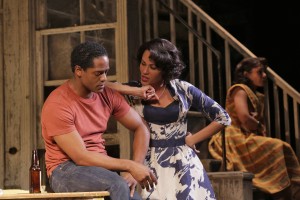‘A Streetcar Named Desire’ seductively simmers on Broadway

The new Broadway production of A Streetcar Named Desire at Broadway’s Broadhurst Theatre is a tempest of unharnessed yearning, sexuality and, of course, desire. The talented multi-racial cast breathes new, provocative life into the Tennessee Williams classic, anchoring their performances around a painful reality of dashed expectations and broken promises.
Leading the charge is Nicole Ari Parker as Blanche DuBois, a southern belle who uses her appearance and formalities as a defense mechanism to hide her alcoholism and weaknesses. She’s a character for the history books, and Parker finds several new elements in the appealing female. For some reason, this Blanche feels more like a victim, more broken and in need of repair. Parker couples a believable accent with a palpable fragility to offer one of the best performances on Broadway this season. From her first footsteps off the “streetcar named desire” to those final prophetic words (“I have always depended on the kindness of strangers”), Parker is in complete control of this uncontrollable character.
The challenge of adding something new to this iconic role is doubly difficult in the New York theater scene. Cate Blanchett’s equally effective performance at BAM a couple of years ago still lingers in the minds of those select audience members who were able to score a ticket. Parker never pays homage to the actresses who’ve embodied Blanche in the past; she starts afresh, tearing down the southern belle and building her back up again (just to be demolished once more).
Blair Underwood provides a nice companion performance with his Stanley. Hot-headed and gruff as usual, the actor finds the inherent violence behind the character and puts it on display at the Broadhurst. Watching him deal with Blanche and her unusual habits (constant bathing, second guessing, etc.) is like watching a bomb ready to explode. At any minute, it feels like Underwood’s Stanley could tear apart the dilapidated two-room apartment where he lives with Blanche’s sister, Stella (Daphne Rubin-Vega). Everything and everyone in the small space has a woman’s touch and a man’s punch, as if it were all brought together over booze and brawls.
Rubin-Vega’s Stella is another highlight. Pulled between her sister and her husband, the character is pivotal. In many ways, Williams created Stella as a stand-in for the audience. We are unable to understand the violence of Stanley or the mysterious seductiveness of Blanche, but we can feel pulled between the two extremes. The variety of decisions that Stella needs to process — everything from leaving Stanley to trusting her sister — are contemplations that run through the audience’s collective mind. Rubin-Vega humanizes this part and offers perhaps the most heartbreaking performance of the play. By the production’s end, when Blanche faces her uncertain future, it’s Stella’s screaming that haunts us long after the curtain has dropped.
The rest of the cast, including Wood Harris as Mitch, are all fine in their supporting roles. Of particular note is the presence of the legendary Carmen de Lavallade, one of the most celebrated dancers of our time, in a dual role as a Mexican woman and neighbor to Stella and Stanley. Watching her move those legs, even for a few seconds, is worth the price of admission.
Director Emily Mann keeps the action finely focused and always brimming with excitable action. Terence Blanchard provides some nice, connective music that ties everything together. Eugene Lee’s set is appropriately dull and sparse.
The story of Blanche, Stella and Stanley has entered the annals of theatrical history. Most people know what to expect from a production of A Streetcar Named Desire, whether their memory stems from the famous cinematic treatment or previous Broadway outings. Finding something new in these magnificent words from one of the best playwrights in American history can be a challenge — an obstacle that could prove to be the demise of an otherwise worthy project. Mann’s interpretation, cemented by near-perfect acting, discovers new energy in the old piece. It’s not so much that the cast now features multi-racial actors (this also occurred with Wiliams’ Cat on a Hot Tin Roof a couple of years ago on Broadway), but much more has to deal with the new interpretations that these exquisite actors bring to the play.
I’ve seen Blanche, Stella and Stanley on stage before, and yet after watching Underwood, Parker and Rubin-Vega, I’m not sure if memory serves me right. These characters are new creations, perhaps wearing the same lines of dialogue like a soldier wears armor, but there’s a new interpretive heart underneath.
By John Soltes / Publisher / John@HollywoodSoapbox.com
-
A Streetcar Named Desire
-
Written by Tennessee Williams
-
Directed by Emily Mann
-
Starring Nicole Ari Parker, Blair Underwood, Daphne Rubin-Vega and Wood Harris
-
Running time: 160 minutes
-
Currently playing at the Broadhurst Theatre 235 W. 44th St. in New York City. Click here for more information.
-
Rating:





